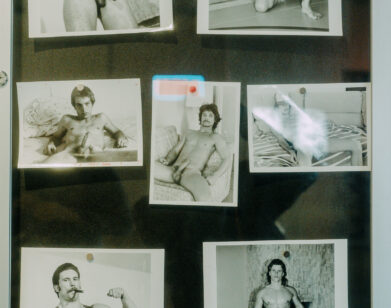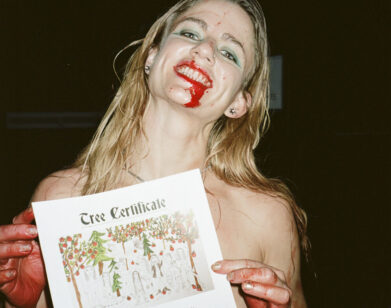Laura van den Berg’s Continental Drift

ABOVE: LAURA VAN DEN BERG. PHOTO BY WENJUN MIAKODA LIANG
The offices of Farrar, Straus and Giroux, the publisher of Laura van den Berg’s second short story collection, The Isle of Youth, are drenched in literary history. Pulitzers and other prizes of major note awarded to FSG authors wallpaper the reception area. Walking in, one can’t shake the feeling that everything that happens here is momentous. The Isle of Youth is no exception. Van den Berg, a blonde woman whose extreme friendliness might seem like a ploy if she weren’t so damn charming, has written a collection filled with mystery, disappearing husbands and fathers, and occasional violence. It ranges from Paris to the Antarctic to a band of bank robbers in the American Midwest. Her writing style is clear, concise, and explores the spaces between perception and reality. We sat down with van den Berg to discuss first person narration, her existential noir influences, and the mystery of the self.
MICHAEL HAFFORD: In the opening story, “I Looked for You, I Called Your Name,” the narrator talks about being “half-present, half-absent.” I noticed this camera-type narrator running through six of the seven stories, with the exception of “The Greatest Escape.” What led you to those more passive narrators?
LAURA VAN DEN BERG: I was having a conversation about first-person narration with my friend who’s a writer, her name’s Elliot Holt, and she made this great observation where the “I” is an “eye” that really resonated with me. I think of that first person as a roving camera, and you’re seeing where they choose to let the lens fall. And that’s one of the most interesting logical components of first person—what the character is choosing to reveal and what they conceal. The tension between what is shown and what is hidden. I think these characters are desperate to tell their story, desperate to show the reader something, desperate to tell the reader something true, but also equally desperate to conceal certain aspects of who they are and why they’ve done what they’ve done.
HAFFORD: The sense of dislocation is very strong in the title story, “The Isle of Youth,” where the twin switches places with her sister. At a certain point we become unsure of whether the sister even actually exists. The ending to that story feels like the beginning of a longer narrative. What led you to that ending or to the endings of other stories in the collection, which also have a generative quality?
VAN DEN BERG: Unlike a novel, where you expect a different kind of arc that leaves us with a somber sense of resolution, I think a story in some ways as like a train window: being able to watch the landscape pass for a certain amount of time. And then your stop arrives, and you have to leave. You don’t necessarily ride the train to its final destination. I also think of one of my favorite saying about short stories: that an ending should be more like an open window than a closed door. It should enlarge the world; it should enlarge our sense of complexity. I was looking for endings that opened another door in stories, to leave with that sense of enlarging possibilities.
HAFFORD: “Opa-Locka” raised a lot of questions for me. It was the most mysterious of the stories, and one that I felt I had very little access to. What do you feel is the mirroring between the missing man and the father who later turns out not to be missing?
VAN DEN BERG: Structurally, there are a lot of noir tropes in this book. I love noir, quite obviously. A lot of the doubles, the mirroring, is part of that. When I say noir, I’m not thinking hard-boiled noir like Chinatown. I’m thinking more what you might call existential noir. I was watching a lot of [Italian director Michelangelo] Antonioni, like The Passenger and L’Avventura, which is a lot about vanishing and identity and erasure. And also some of Hitchcock’s movies, Vertigo, where there’s a lot of doubling and a lot of mirrors.
For me, the parallel between the two missing men is one who is present at the beginning of the story disappears. The other man, who is absent at the beginning of the story, reappears halfway through. In some ways, on a structural level, I see Mr. Defonte and the father as almost changing places—one man leaves and another man manifests. Through the sisters we see different… I think it’s really interesting how differently we can process grief, loss, mystery. Some people, their inclination is to disengage with it as much as possible, other people really want to wait more. Through the sisters, we see another kind of mirror parallel, where one sister deals with in one way and the other sister deals with it another way. The only character in that story who has a really definite end is Julia, the sister, because she dies. That was what I saw her trajectory as being and I wanted that trajectory to complete. At the end of the story, the narrator is left with a sea of questions about her father, Mr. Defonte, her sister, about her capacities when it comes to confronting this. There’s that moment when she almost goes to confront her father to say, “This is what you did to us, and this is what happened as a result.” But she can’t quite make that last step. Again, there’s that tension between what she’s willing to face and what she’s running away from. When it ends back at the opera house, that’s her way of facing and not facing; facing in that she’s returning in some ways to the source, which is Mrs. Defonte, but not facing in the sense that the real source, which is the father, is still sort of mysterious.
HAFFORD: I think it’s interesting you bring up L’Avventura, because so many times in this collection there is a disappearance of someone—usually either a husband or a father. Is that trope coming from noir? What led you to bring that back and back and back?
VAN DEN BERG: It definitely started happening organically at first. When I started this collection, the first three stories I wrote were “Acrobat,” “The Isle of Youth,” and “I Looked for You, I Called Your Name.” At first there was not master plan, I was just sort of taking breaks to write stories because I was like, “I can’t write this novel anymore, I have to do something else with my life for a little bit.” [laughs] So I would take a break and work on a story. But at a certain point, after I had written four of these stories, I would have to be pretty inattentive to be like, “Huh, there’s a lot of detectives, there are a lot of disappearances, something obviously is going on here.” I had been watching a lot of Hitchcock and Antonioni, and I started thinking about how perhaps I could see these outside influences were merging with internal preoccupations. I didn’t start out by thinking “I’m going to write stories that are nodding to noir.” It was definitely a merging of those internal preoccupations with outside sources. I think in a lot of ways, if you really strip down some of the most compelling novels, in a lot of ways, they’re detective stories. I love Javier Marias, I love his novel Tomorrow in the Battle Think on Me. That book opens with a mysterious death. The whole book is a detective story. In the best incarnations, the mystery the self—the book is just as much about that as about how and why this woman died. That idea of the mystery of the self and examining those internal mysteries alongside external mysteries became a very present preoccupation as I worked on the stories.
THE ISLE OF YOUTH IS OUT NOW. LAURA VAN DEN BERG WILL APPEAR NOVEMBER 6 AT COMMUNITY BOOKSTORE IN PARK SLOPE IN CONVERSATION WITH JASON DIAMOND FOR THE LAUNCH OF THE ISLE OF YOUTH. SHE WILL ALSO APPEAR AS PART OF THE FSG ORIGINALS SERIES, PRESENTED BY FSG, GQ, AND FLAVORPILL, WITH SLOANE CROSLEY AND MUSICAL GUEST STEVE GUNN ON NOVEMBER 13 AT STUDIO-X IN LOWER MANHATTAN.






